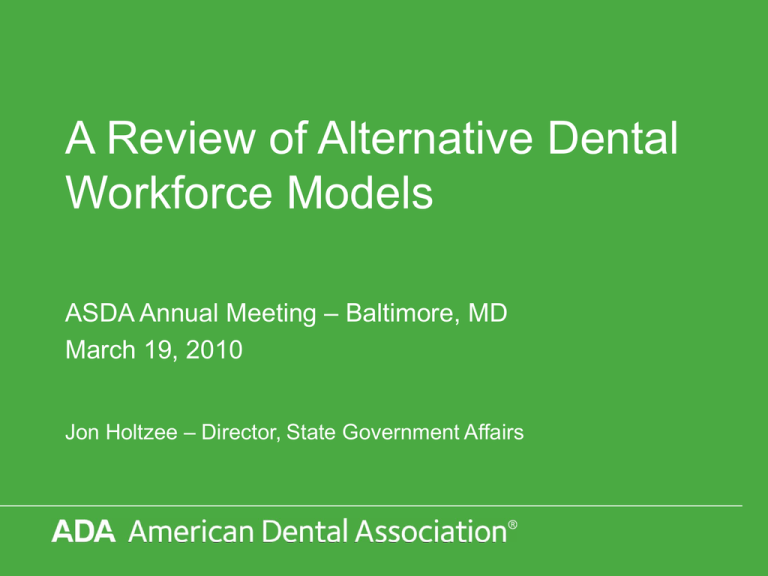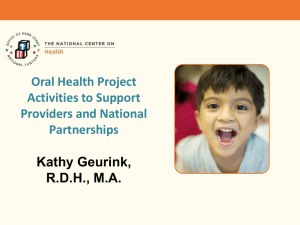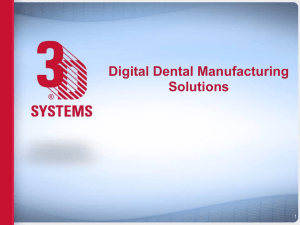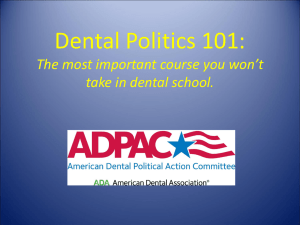
A Review of Alternative Dental
Workforce Models
ASDA Annual Meeting – Baltimore, MD
March 19, 2010
Jon Holtzee – Director, State Government Affairs
See one model – you’ve seen one model
While different stakeholders painstakingly
create various models, the legislative and
regulatory process in each state guarantee
variation will be inevitable state to state.
Factors include:
• Education requirements
• Local need
• Political Culture
© 2010 American Dental Association, All Rights Reserved
See one model – you’ve seen one model
• Dental Health Aide Therapist (DHAT)
• Advanced Dental Hygiene Practitioner
(ADHP)
• Basic Dental Therapist (MN)
• Advanced Dental Therapist (MN)
• Pediatric Therapist (ME)
• Oral Health Practitioner (MN)
• Community Dental Health Coordinator (ADA)
© 2010 American Dental Association, All Rights Reserved
1st out of the box - DHAT
• Currently restricted to Alaska and IHS
(pending)
• High school grads; 18 month training
program
– 1st year at Univ. of Washington School of
Medicine
– 2nd year is clinical training in Alaska
• Design to train from the community, return to
the community
© 2010 American Dental Association, All Rights Reserved
DHAT – Page 2
• After graduation initial
work site is
supervised
• Supervising dentist
makes assessment of
skills and issues
standing orders
• Remote supervision
• Scope
–
–
–
–
–
–
Diagnosis
Restorations
Prophys
Extractions
Pulpotomies
Crowns
• Regulation
– Not state sanctioned
– Tribal certification
© 2010 American Dental Association, All Rights Reserved
Advanced Dental Hygiene Practitioner (ADHP)
• Proposed by ADHA
• 2 year Master’s program
• Design – “. . .this new level dental hygienists
would provide diagnostic, preventive,
restorative and therapeutic services directly
to the public.”
© 2010 American Dental Association, All Rights Reserved
ADHP – Page 2
• “Supervised” by a
collaborative
management
agreement – standing
orders
• Undefined referral
systems
• Regulation
– Licensure
• Scope
–
–
–
–
–
–
–
–
–
Full hygiene scope
Restorations
Extractions
Pulpotomies
Locals
Rx
Recement crowns
Diagnosis
Pulp capping
© 2010 American Dental Association, All Rights Reserved
Dental Therapist (Minnesota)
• Education
– Basic = Bachelor’s degree
– Advanced = Master’s or post-grad certification
program + 2000 hours as basic therapist
• Regulation
– Basic = License
– Advanced = Basic License & certification
© 2010 American Dental Association, All Rights Reserved
Dental Therapist – Page 2
• Scope
–
–
–
–
–
–
–
Scripts
ART
Locals
Space maintainers
Pulpotomies
Primary extractions
Pulp Capping
• Advanced Scope
– All of the Basic scope
+
– Permanent extractions
with mobility of +3 or
+4
– Surgical procedures
must still be
authorized by dentist
for each individual
patient
© 2010 American Dental Association, All Rights Reserved
Dental Therapist – Page 3
• Populations & Settings
–
–
–
–
–
–
–
Critical care clinics
FQHCs
Assisted living centers
Collaborative hygiene location
Military & VA facilities
Dental or dental therapy schools
Any setting where at least 50% of the patients are:
• Enrolled in a public program;
• At 200% of FPL or lower with no public or private coverage; and
• DHPSA
© 2010 American Dental Association, All Rights Reserved
Populations & Settings
• While the design was created to direct
treatment to those most in need, enough
latitude exists to have only marginal meaning.
© 2010 American Dental Association, All Rights Reserved
Community Dental Health Coordinator (CDHC)
• Like the DHAT the individual is drawn from the
community to be served
• 18 month education program, pilots at UCLA, Univ.
of Oklahoma and soon at Temple Univ.
• Primary role is as a demand aggregator, patient
navigator. This includes:
–
–
–
–
–
–
Individual and public health education & literacy
Community and organizational networking
Cultural competency
Barrier resolution
Work with other health care professionals & organizations
Triage, scheduling & work chairside with dentist
© 2010 American Dental Association, All Rights Reserved
CDHC – Page 2
• Clinical Scope
– Preventive
•
•
•
•
Fluoride
Sealants
Polishing
Limited scaling
– Temporary
Restorations
– Screening
– Diagnostic data
collection
• Supervision
– General/Remote for
most procedures
– On-site when dentist is
present
– Direct authorization for
Temporary
Restorations
• Regulation
– Undetermined at
present
© 2010 American Dental Association, All Rights Reserved
CDHC (Continued)
A New Dental Team Member with Community Health
Worker (CHW) Skills (concept before program
moved to CAPIR)
CAPIR’s POV:
A Community Health Worker with dental skills
© 2010 American Dental Association, All Rights Reserved
Seven Roles of CHWs
• Bridging/cultural mediation between communities and
health and social service systems
• Providing culturally appropriate health education and
information
• Assuring people get services they need
• Providing informal counseling and social support
• Providing informal counseling and social support
© 2010 American Dental Association, All Rights Reserved
Seven Roles of CHWs – Continued
• Advocating for individual and community needs
• Providing direct service, such as first aid and
administering health screening tests
• Building individual and community capacity
© 2010 American Dental Association, All Rights Reserved
Facts about CHWs
• Approximately 120,000 CHWs working in the
U.S.
• Source: Health Resources and Services Administration.
Community Health Workers National Workforce Study. HRSA
2007; Available at URL:
http://bhpr.hrsa.gov/healthworkforce/chw/default.htm
• For every dollar spent on the CHW there is a
reduction in health care cost of $2.28
– Source: Journal of Health Care for the Poor & Underserved 2006
by Elizabeth Whitley & others
© 2010 American Dental Association, All Rights Reserved
The CDHC Focus
The CDHC’s focus is on reducing the
oral health disparities by
targeting social determinants of oral
disease and improving access to dental
care
PRIMARY PREVENTION
© 2010 American Dental Association, All Rights Reserved
Other Proposals
• Pediatric Therapist
• Supervised Dental Health Aide Therapist type
of position
• OHP (interim language in MN – still
referenced by some)
© 2010 American Dental Association, All Rights Reserved
Political Environment
• Michigan – recent death may lead to increased calls
• Funding – with restricted revenues, policymakers
seek “flashy” solutions with low costs
• Squeaky Wheel – one of the most frequently heard
health care complaints to legislators involved dental care
• Cost Containment – While Democrats may have
been traditionally more attuned to these proposals, many
Republicans embrace them with an eye toward cost
containment in one of each state’s biggest line items –
health care costs.
© 2010 American Dental Association, All Rights Reserved
Political Environment
• Increase Access - Many are legitimately
concerned
• Re-election – Usually a politicians first concern.
How can I look good to most of those who elect me?
• Shiny & New - Foundation support is accelerated by
new proposals, not traditional answers. Additionally,
workforce creation is a more measurable metric
• Education Turf - We saw this emerge as an issue in
MN as competing university systems entered into the
fray.
© 2010 American Dental Association, All Rights Reserved
Example of Foundation Perspectives
Guiding Principles on New Dental Workforce Models
•
The Pew Children’s Dental Campaign believes children should see a
dentist when needed, and when possible. However, we recognize it is not
always possible. Therefore, Pew supports state innovations that show
promise in improving access to preventive and restorative services for
children who cannot access care. Pew supports state efforts to expand the
existing dental health care team with new providers. States are pursuing the
development of new dental providers because:
– Millions of low-income children suffer needlessly from untreated
dental disease. This serious problem is caused in part by a shortage of
dentists who will treat them.
– Shortages of private dentists persist and will worsen. By the year
2014, the number of dentists retiring will outpace the number entering
the workforce, and the ratio of dentists to population will be the lowest it
has been in 100 years. Few dentists locate in rural and frontier areas.
© 2010 American Dental Association, All Rights Reserved
Foundation Perspectives - Continued
•
Medicaid dental programs are chronically underfunded. Most states
pay below the cost of providing the service, and few cover dental care for
parents or other adults.
•
People who cannot afford private dentists have limited options. The
dental safety net of community health centers, dental school clinics, and
hospitals only serves about 10 percent of the 82 million people who need it.
Hospital emergency rooms—which are a last resort for uninsured patients—
only treat for pain and infection, not underlying problems.
The Pew Campaign’s guiding principles for supporting states’ dental workforce
innovations are:
•
Proposals for new workforce models should be based on research and
evidence, from both domestic and international sources.
© 2010 American Dental Association, All Rights Reserved
Foundation Perspective - Final
•
Models should be based on a careful analysis of the state’s particular experience
and needs. This should include collecting baseline data on who is not served by the
current system, the current workforce, and funding for care. Work should involve a
strong, broad-based partnership of stakeholders.
•
The duties and scope of practice of new providers should be designed to address
the needs and problems identified in the state’s analysis. Priority should be given to
preventive and restorative care for children.
•
New dental providers should be adequately educated to perform their scope of
services competently. Educational requirements should conform to national and
international experience and standards. Educational costs to the student must be
minimized to ensure student debt does not create an economic barrier to serving in a
safety net setting.
•
States should adopt the least restrictive level of supervision that maintains patient
safety. Supervision requirements that go beyond the level supported by evidence
unduly limit the ability of new dental providers to bring quality care to the children who
need it.
© 2010 American Dental Association, All Rights Reserved
Public Perceptions
•
•
•
•
•
•
Are comfortable with medical mid-levels
Want lower costs
Want more access
Mixed opinion on quality and safety
May distrust institutions
Overwhelmed by information
© 2010 American Dental Association, All Rights Reserved
What’s the Answer?
• Well that depends. . .
© 2010 American Dental Association, All Rights Reserved







